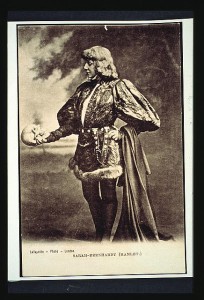This fifth excerpt from a magazine article in Belgravia, an Illustrated London Magazine, published in 1878, describes the history of props in Western European theatrical traditions up to the late nineteenth century. I’ve split it into several sections because it is rather long and covers a multitude of subjects, which I will be posting over the next several days.
Stage Properties by Dutton Cook, 1878
Nor is he more necessary to pantomime and melodrama than to Shakespeare. Grimaldi, indeed, upon occasions, finding a scarcity of the appliances necessary to the business of harlequinade, resorted to the public markets, and made live pigs, ducks, and geese do duty for the usual property animals—the property-man, very likely, thinking poorly of such efforts of nature in comparison with the works of art he would have produced had time permitted; just as Mr. Johnson [Eric: His name is actually Alexander Johnston, not Johnson], the machinist of Covent Garden, viewing Chunee, the real elephant at Drury Lane, is reported to have said: ‘I should be very sorry if I couldn’t make a better elephant than that!’ But as a rule no performance is possible without the property-man. What, for instance, would ‘Macbeth’ be, bereft of its properties: its witches’ cauldron, eye of newt and toe of frog, apparitions, torches, crowned kings, the dagger with which Duncan is slain and the bloodstains which are afterwards to render Macbeth’s hands ‘a sorry sight’? How could ‘Hamlet’ be played without the partisans of Francisco and Bernardo, the fencing foils for the last scene, the poisoned cup out of which Gertrude is inadvertently to drink, the book Hamlet is to read, denouncing its slanders, the miniature portraits upon which he is to descant, and that famous skull—once adorning the shoulders of Yorick, the king’s jester—over which he is to muse?
This skull seems oftentimes to have been no figment or property of pasteboard, but a real thing—there being so many skulls about in the world, and obtainable at a small cost—although there is a story told of a sheep’s head being brought on as a property to serve the purpose of the scene, and enable Hamlet to meditate as usual and point the accustomed morals. This involved a bad compliment to the departed Yorick, however, and assumed the complete ignorance of the audience in regard to comparative anatomy. Nor is it to be believed that Hamlet could seriously repeat his philosophical speeches, gazing steadily the while at the straightened forehead of the innocent sheep. Macready relates in his Diary of his performing ‘ Hamlet’ at Boston, U.S., in 1848: ‘Was struck at the grave scene with the extraordinary weight of the skull which was given to me. I thought it was loaded; then it occurred to me it might be filled with earth—but no. Mr. Ayling observed to me it might be a negro’s skull; looking at the receding forehead, I perceived it was so. But, directly, this circumstance seemed to confirm to me Agassiz’s theory, that the brain did not develop itself after childhood; the brain does not grow, but the bone does. The weight of this skull went in confirmation of this ingenious theory.’ Of a subsequent performance at Richmond in the same year he writes: ‘Acted Hamlet, taking much pains, and, as I thought, acting well; but the audience testified neither sensibility nor enthusiasm, and I suppose it was either not good or “caviare to the general.” They gave me the skull, for Yorick’s, of a negro who was hung two years ago for cutting down his overseer.’
(Dutton Cook. “Stage Properties.â€Â Belgravia, vol. 35. 1878: pp. 290-291.)


